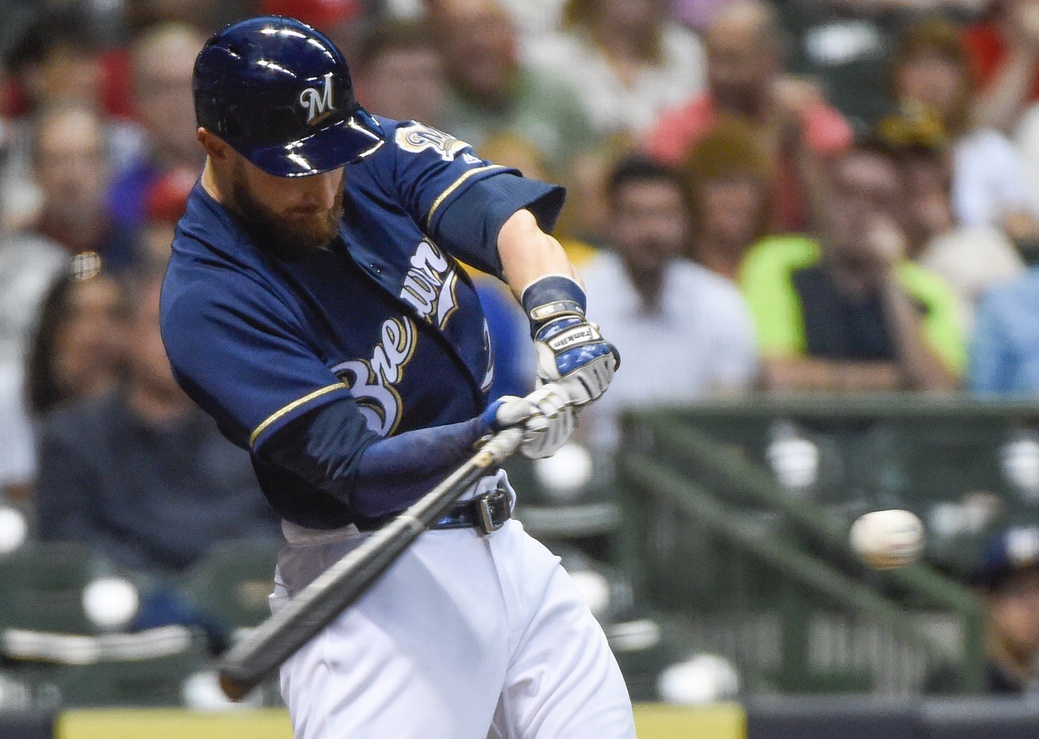If the Brewers were better this year, the Jonathan Lucroy for MVP movement would likely be picking up steam. Lucroy’s 2.5 BWARP leads all catchers, fueled by his brilliant .316/.372/.539 batting line. His defensive reputation is as good as it gets, and his bat is fully recovered from his injury-riddled 2015. Few players bring the two-way production Lucroy boasts when he’s at his best, and 2016 is looking like it could be his greatest season yet.
It seems obvious that the Brewers will try to move Lucroy soon, as he has just one more year remaining on his contract after this season, and it’s unlikely Milwaukee will compete in 2017. Somebody will need a catcher — the White Sox and Rangers seem like particularly good candidates, and injuries could make more buyers by the trade deadline. But while Brewer Nation has been more or less preparing for a trade since last winter, I think it’s at least worth exploring what a contract extension for the team’s best player might look like.
Unfortunately, we don’t have a lot of data for what an elite catcher nearing free agency can expect to get. Catcher is such a difficult position to play both in terms of the unique skills it requires and the physical toll it takes that by the time most catchers have the six years of service time necessary to hit free agency, they’ve either moved to a new position or are well on the wrong side of 30. That’s why, among current players, there is only one catcher with a contract worth over $100 million in San Francisco’s Buster Posey — Joe Mauer’s $184 million contract also remains on the books, but he has been a first baseman for some time now.
The $31 million extension Francisco Cervelli signed this month ranks as the seventh largest at the position. And in free agency, there have only been two contracts in the past 10 years longer than three years and richer than $30 million: Russell Martin’s five-year, $82 million deal with the Blue Jays signed before the 2015 season, and Brian McCann’s 5-year, $85 million deal signed before the 2014 season. Other than that, only four other catchers have signed deals of even three years in free agency (Carlos Ruiz, Jarrod Saltalamacchia, John Buck and Bengie Molina) in the past decade.
Lucroy’s age alone likely disqualifies him from matching the nine years and $167 million Posey got from the Giants in 2013, when he was just 26 years old. Lucroy turns 30 in exactly a week. He’ll be in his age 31 season if he hits the free agent market after his current contract expires, just as Martin was before the 2015 season and one year older than McCann was when he hit the free agent market the season before.
McCann and Martin serve as decent comparisons for Lucroy. Lucroy’s 2014 and Martin’s 2008, their career years, are comparable by BWARP (7.9 vs. 8.3). Martin had three All-Star appearances before he hit free agency; Lucroy will almost certainly receive his second All-Star berth this season. McCann, however, was on another level offensively, with four seasons of at least 7.0 BWARP and seven All-Star appearances in the eight seasons he spent in Atlanta. Given inflation, Lucroy could certainly best the contracts given to McCann and Martin, but given the similarities in age and production, it’s hard to imagine he’ll beat them by too much.
While Lucroy has certainly played like a $100 million player, the volatility and difficulty of the catcher position makes it difficult to justify investing money and years — particularly years — in a free agent contract behind the plate. On the one hand, this might make an extension more palatable for Milwaukee — over the next six years, most of Milwaukee’s best players will be in either their pre-arbitration or arbitration years, especially if they manage to move Ryan Braun this season. The Brewers won’t have much money committed to the long-term and would be hard pressed to find a better player available to them for as little money as Lucroy, simply due to the fact he’s a catcher. Of course, that positional volatility might be exactly why the Brewers should cash in on Lucroy now via the trade market rather than gamble on his health and ability to play regularly behind the plate into his mid-30s.
The history suggests, though, that Lucroy will be more affordable than most players of his ability level. The Brewers should certainly continue to listen to trade offers centering around him, as a desperate team may be willing to unload a significant chunk of their farm system in order to improve at such a shallow and difficult position. If that happens, fantastic. But if Lucroy is willing to sign an extension resembling those signed by McCann or Martin — in the 5-year, $80-100 million range — he could serve as the club’s franchise player and hopefully the farm system would produce the players necessary to build around him.
A trade remains the most likely outcome, but the Brewers don’t need to be hasty. History suggests that Lucroy, despite his greatness, is not going to be so expensive that the Brewers will automatically be priced out of the market like Prince Fielder, Zack Greinke and others have been in the past. The Brewers can use this knowledge as leverage as they fish for offers in the trade market and be selective for the very best deal as a result.

1 comment on “What Would a Jonathan Lucroy Extension Look Like?”